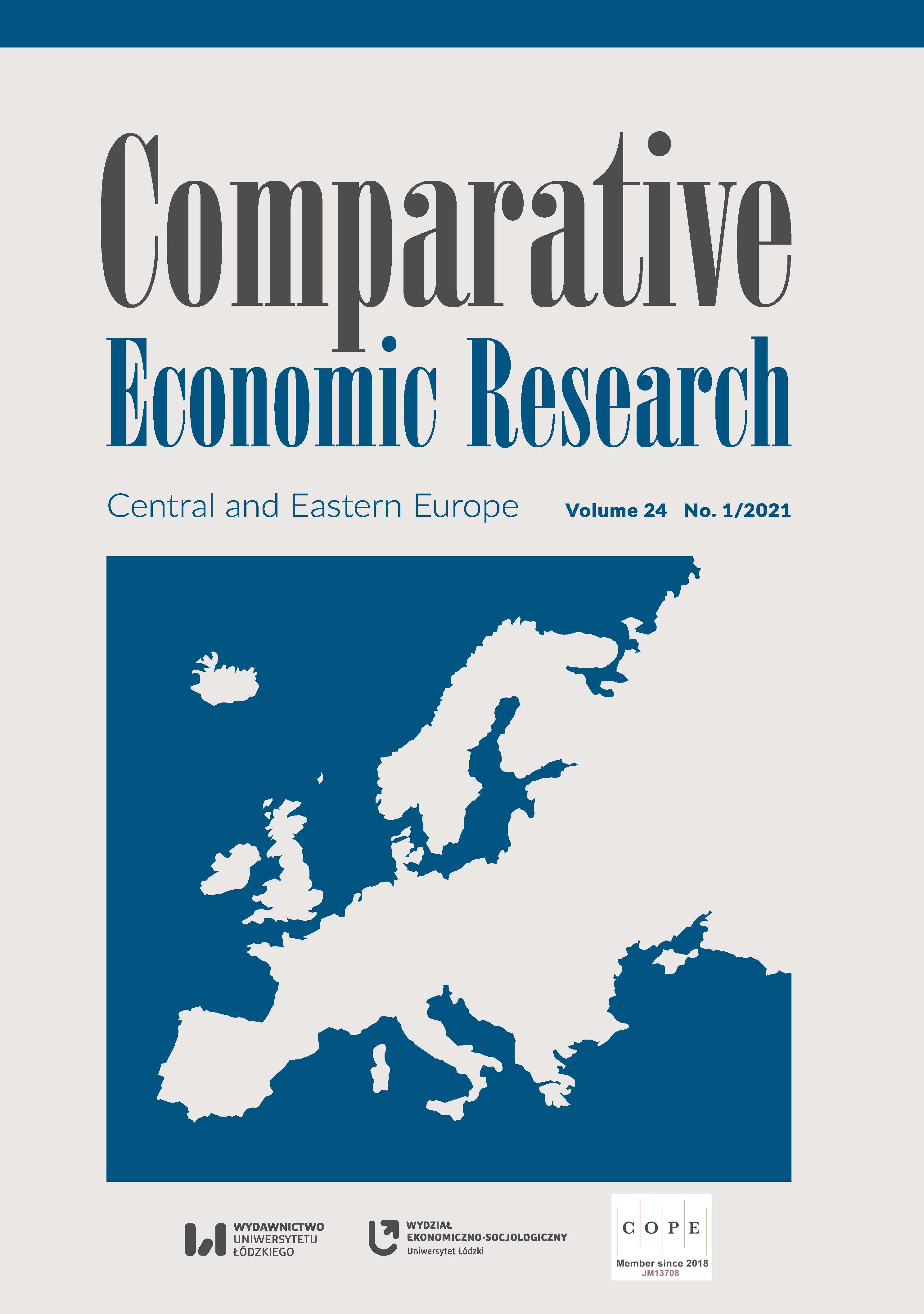Aspiracje migracyjne Ukraińców do Niemiec: analiza i scenariusze rozwoju
DOI:
https://doi.org/10.18778/1508-2008.24.04Słowa kluczowe:
aspiracje migracyjne, czynniki społeczno-ekonomiczne, prognoza, polityka migracyjna, Ukraina, NiemcyAbstrakt
Na podstawie modelu regresji wielokrotnej i podejścia scenariuszowego do prognoz oszacowano ukraińskie aspiracje migracyjne do Niemiec (skala migracji, aktywność gospodarcza migrantów i ich korzyści ekonomiczne). Argumentuje się, że poważne zmiany w strukturze wiekowej i płci ludności lokalnej mogą powodować kryzys demograficzny i utratę równowagi na rynku pracy. Przedstawione prognozy wskazują na rosnącą rolę zagranicznych zasobów ludzkich w niemieckiej gospodarce. Modelując skalę emigracji z Ukrainy zastosowano podejście zintegrowane, uwzględniające nie tylko trendy czynników przyciągających, ale także szczególne aspekty niemieckiej polityki migracyjnej i odpływ 8–10 milionów ukraińskich pracowników. Biorąc pod uwagę brak wystarczających danych statystycznych dotyczących skali emigracji zarobkowej, potrzebnych do budowy wiarygodnych modeli ekonometrycznych, uzasadniono, że zastosowanie eksperckiej metody prognozowania pozostaje optymalną techniką oceny potencjalnych przepływów migracyjnych i systemów migracji.
Pobrania
Bibliografia
All-Ukrainian Population Census (2001), Statistics Database, http://www.ukrcensus.gov.ua/eng/ (accessed: 15.05.2019).
Google Scholar
Ausländische Bevölkerung (n.d.), https://www.destatis.de/DE/Publikationen/Thematisch/Bevoelkerung/MigrationIntegration/AuslaendBevoelkerung.html (accessed: 2.05.2019).
Google Scholar
Bijak, J. (2006), Forecasting international migration: Selected theories, models, and methods, CEFMR Working Paper 4, Central European Forum for Migration Research, Warsaw, https://pdfs.semanticscholar.org/c67f/39cc621207bf34c63f371108a6021102744f.pdf (accessed: 2.05.2019).
Google Scholar
Bil, M. (2017), Retrospective survey of spatial mobility of the population, “Demography and Social Economics”, 1, pp. 66–78, https://doi.org/10.15407/dse2017.01.066
Google Scholar
DOI: https://doi.org/10.15407/dse2017.01.066
Einbürgerungen (n.d.), https://www.destatis.de/DE/Publikationen/Thematisch/Bevoelkerung/MigrationIntegration/Einbuergerungen.html (accessed: 31.05.2019).
Google Scholar
Federal Statistical Office of Germany. Statistics Database (n.d.), https://www-genesis.destatis.de/genesis/online/data (accessed: 2.06.2019).
Google Scholar
Hyndman, R.J., Booth, H. (2008), Stochastic population forecasts using functional data models for mortality, fertility and migration, “International Journal of Forecasting”, 24 (3), pp. 323–342, https://doi.org/10.1016/j.ijforecast.2008.02.009
Google Scholar
DOI: https://doi.org/10.1016/j.ijforecast.2008.02.009
Keilman, N., Pham, D.Q. (2004), Empirical errors and predicted errors in fertility, mortality and migration forecasts in the European Economic Area, Discussion Paper, No. 386, Social and Demographic Research, Statistics Norway, https://www.researchgate.net/publication/24132711_Empirical_errors_and_predicted_errors_in_fertility_mortality_and_migration_forecasts_in_the_European_Economic_Area (accessed: 11.07.2019).
Google Scholar
“Kurier” (2018), Bevölkerung: Westeuropa wächst, Osteuropa schrumpft, https://kurier.at/chronik/weltchronik/bevoelkerung-westeuropa-waechst-osteuropa-schrumpft/400054985 (accessed: 4.06.2019).
Google Scholar
Libanova, E. (2010), Population of Ukraine. Labour emigration in Ukraine, Ptoukha Institute for Demography and Social Studies of the National Academy of Sciences of Ukraine, Kyiv.
Google Scholar
Libanova, E.M., Pozniak, О.V., Makarova, О.В., Sarioglo, V.G., Tkachenko, L.G. (2009), External labour migration of population, Ukrainian Centre for Social Reforms, Kyiv.
Google Scholar
Mahmoud, O., Trebesch, T., Trebesch Ch. (2010), The economics of human trafficking and labour migration: Micro-evidence from Eastern Europe, “Journal of Comparative Economics”, 38, pp. 173–188, https://doi.org/10.1016/j.jce.2010.02.001
Google Scholar
DOI: https://doi.org/10.1016/j.jce.2010.02.001
Malynovska, O. (2013), The policy of neighbouring countries with regard to compatriots as an instrument for replenishing human resources: challenges and lessons for Ukraine, “Strategic Priorities”, 3 (28), pp. 138–146.
Google Scholar
Malynovska, O. (2015a), Labour migration of Ukrainian population: what to expect at the nearest future?, “Migration (Electronic Analytical Newspaper)”. April 29, http://migraciya.com.ua/upload/d75da205ca27e012961fe39b5b3da33c.pdf (accessed: 15.05.2019).
Google Scholar
Malynovska, O. (2015b), Possible development of labour migration abroad in the context of current situation in Ukraine, “Journal of Pension Fund of Ukraine”, 3 (153), pp. 10–15.
Google Scholar
Mansoor, A., Quillin, B. (2006), Migration and Remittances: Eastern Europe and the Former Soviet Union, The World Bank, Washington, https://doi.org/10.1596/978-0-8213-6233-4
Google Scholar
DOI: https://doi.org/10.1596/978-0-8213-6233-4
Mulska, O., Baranyak, I. (2019), Formation of the forecasting model for Ukrainian-German migration system, “Economy and Forecasting”, 2, pp. 119–136, https://doi.org/10.15407/econforecast2019.02.119
Google Scholar
DOI: https://doi.org/10.15407/econforecast2019.02.119
Ovchynnikova, O. (2017), Models of Regional Migration of the Population, “Intelekt XXI ”, 4, pp. 27–32.
Google Scholar
Poznyak, O., Shevchuk, P. (2014), Demographic perspectives of Ukraine until 2060, “Demography and Social Economy”, 1 (21), pp. 72–84, https://doi.org/10.15407/dse2014.01.072
Google Scholar
DOI: https://doi.org/10.15407/dse2014.01.072
Sadova, U., Hrynkevych, O., Semiv, L., Teslyuk, R., Bil, M., Bidak, V., Ryndzak, O., Levytska, O., Mulska, O. (2019), Ukrainian migration in the context of the global and national challenges of the 21st century, International Labour Organization in Ukraine, Dolishniy Institute of Regional Research of the National Academy of Sciences of Ukraine, Lviv Polytechnic National University, Lviv.
Google Scholar
Sarioglo, V.G. (2016), Great data as a source of information and tools for official statistics: potential, problems, perspectives, “Statistics of Ukraine”, 4, pp. 12–19.
Google Scholar
State Migration Service of Ukraine (2017), Migration profile of Ukraine. State Migration Service of Ukraine, Kyiv, https://dmsu.gov.ua/assets/files/mig_profil/migprofil_2017.pdf (accessed: 14.06.2019).
Google Scholar
State Statistics Service of Ukraine (2018), Population of Ukraine in 2017. Demographic Yearbook, Kyiv, http://database.ukrcensus.gov.ua/PXWEB2007/ukr/publ_new1/2018/zb_dy_2017.pdf (accessed: 2.07.2019).
Google Scholar
State Statistics Service of Ukraine. Statistics Database (n.d.), http://www.ukrstat.gov.ua (accessed: 10.06.2019).
Google Scholar
Wickramasekara, P. (2008), Globalisation, international labour migration and rights of migrant workers, “Third World Quarterly: Special Issue on Globalisation and Migration: New Issues, New Politics”, 29 (7), pp. 1247–1264, https://doi.org/10.1080/01436590802386278
Google Scholar
DOI: https://doi.org/10.1080/01436590802386278
Pobrania
Opublikowane
Jak cytować
Numer
Dział
Licencja

Utwór dostępny jest na licencji Creative Commons Uznanie autorstwa – Użycie niekomercyjne – Bez utworów zależnych 4.0 Międzynarodowe.











